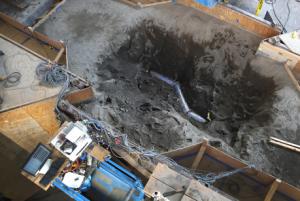Earthquake resilienceEarthquake-resilient pipeline could allow Los Angeles’s water utility system withstand tremors
Los Angeles’s water utility system – the nation’s largest — crosses over thirty fault lines en route to supplying water to more than four million residents. A top engineer from the city of Los Angeles visited Cornell University this month as researchers tested a new earthquake-resilient pipeline designed better to protect southern California’s water utility network from natural disasters. The steel pipe uses a unique structural wave design to control buckling, allowing the pipe to bend and compress without rupturing or losing water pressure.

Quake resilient pipe being tested // Source: cornell.edu
A top engineer from the city of Los Angeles visited Cornell University this month as researchers tested a new earthquake-resilient pipeline designed better to protect southern California’s water utility network from natural disasters. They ran multiple tests, including an earthquake simulation in which a 28-foot-long section of the pipe was outfitted with more than 120 monitoring instruments and buried within 80 tons of soil – an experiment that took over a month for the research team to prepare.
Cornell U says that the test mimicked a fault rupture that can occur during an earthquake when global plates begin to slip past each other, causing the ground to shift and deform. A large, hydraulically powered “split box” imposed two feet of fault rupture along a 50-degree angle, forcing the buried pipeline into a combination of compression and bending.
“The pipe was able to accommodate the two feet and didn’t spring a leak,” said Brad Wham, a geotechnical engineering postdoc from Cornell who designed the test, which was performed at the Cornell Geotechnical Lifelines Large-Scale Testing Facility. “We took the pipe to three times its current design standard, and it continued to convey water. So we consider it a successful test and very promising technology.” And while the test pipe was only eight inches in diameter, Wham says the results are scalable and could be applied to pipelines as large as seventy inches in diameter or greater.
“It surpassed expectations,” said Tom O’Rourke, professor of civil and environmental engineering at Cornell University and the project’s principal investigator.
The steel pipe, developed by JFE Holdings in Japan, uses a unique structural wave design to control buckling, allowing the pipe to bend and compress without rupturing or losing water pressure. The wave features are installed at key locations along the pipeline to absorb large ground deformation, such as movements imposed by earthquakes and landslides or from undermining associated with scour during hurricanes and floods. The extent of its performance was unknown until it arrived at Cornell.
The results are significant for Los Angeles and other West Coast cities that want to upgrade their aging utility systems, especially portions that cross over fault lines. Craig Davis, the resilience program manager for L.A.’s Department of Water and Power, attended the testing and said his city’s water utility system – the nation’s largest — crosses over thirty fault lines en route to supplying water to more than four million residents. The new pipe produced by JFE Holdings now gives Davis and other engineers a new option for securing water supply to the city’s most vulnerable areas.
Los Angeles is upgrading its water utility system through the “Resilience by Design” program implemented by Mayor Eric Garcetti, and other municipalities around the country are eager to initiate similar programs following natural disasters like Hurricane Katrina and Superstorm Sandy. “What we’ve actually seen is a paradigm shift in pipeline technology, and it’s a market-driven research environment,” said O’Rourke, who added that a steady stream of business from manufacturing companies like JFE Holdings has kept his facility in high demand. “All of the West Coast utilities say that if you want us to consider your pipe, you have to test it Cornell. Ours is the only facility in the world that can perform these kinds of tests.”
Following the fault rupture test, the research team spent three days carefully excavating the pipeline and will begin collecting additional data based on its deformation. The results will help officials identify the most strategic locations for the new pipeline to be installed.
“We modeled the Los Angeles water supply and have the entire system on a secure computer,” said O’Rourke. “We created the next generation of hazard-resilient network modeling, and they actually used it to develop policy and emergency response operations.”
Cornell notes that Los Angeles is not the only city to benefit from Cornell’s testing facility. San Francisco has implemented fault rupture hazard solutions for pipelines validated by Cornell, with Portland, Seattle, and Vancouver all considering upgrades based on recent test results.
— To download videos and photos captured during the testing process, visit https://cornell.box.com/v/pipelinetest. You can also watch a time lapse video of the testing and excavation process on YouTube.
